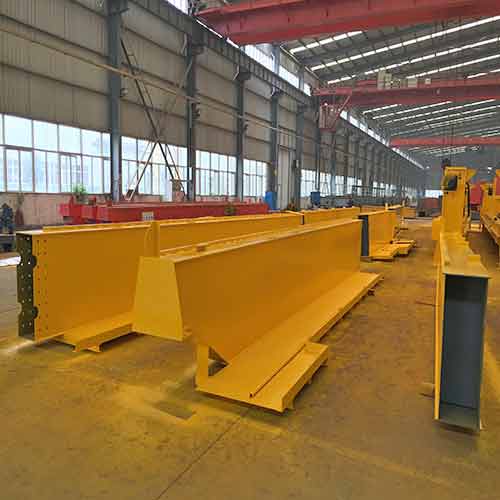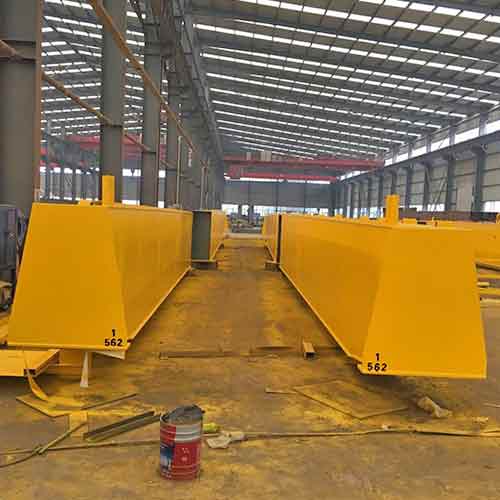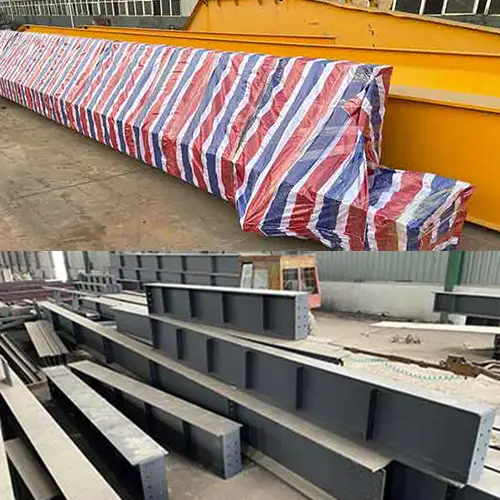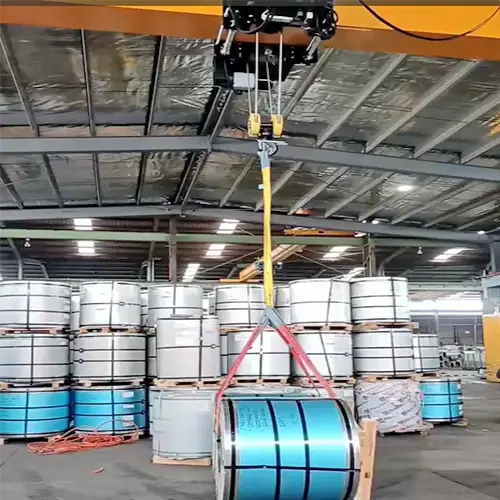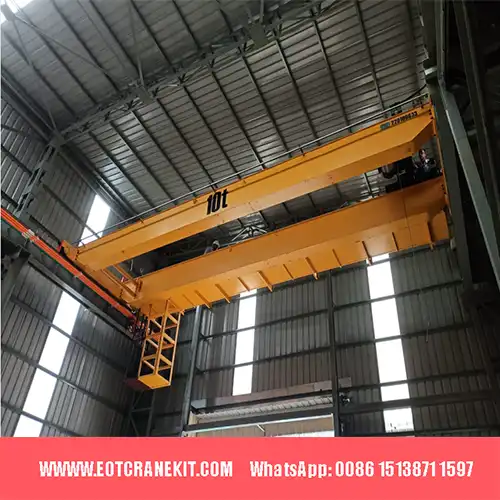What are Your Choices for 10 Ton Double Girder Overhead Cranes?
Explore key considerations, types, customization, costs, and safety standards for selecting the ideal 10-ton double girder overhead crane. Get your design!
Category: 10 Ton Overhead Crane
Your Trusted 10 Ton Overhead Crane Manufacturer & Supplier
Guide to Choosing the Right 10 Ton Double Girder Overhead Cranes
What are Your Choices for 10 Ton Double Girder Overhead Cranes?
Explore key considerations, types, customization, costs, and safety standards for selecting the ideal 10-ton double girder overhead crane.
Double girder overhead cranes are robust lifting machines designed to handle heavy loads with precision and efficiency. Featuring two parallel girders, these cranes offer increased stability and higher load capacities compared to single girder cranes, making them suitable for demanding industrial applications.
Definition and Basic Functionality
Double girder overhead cranes consist of two horizontal girders supported by end trucks, which travel along rails mounted on runway beams. The hoist, which moves along the girders, lifts and lowers loads, while the entire crane structure can move along the length of the rails. This configuration provides a wide operational area and enables precise positioning of heavy materials. The primary components include the girders, hoist, trolley, end trucks, and control system.
Importance in Industrial Settings
Double girder overhead cranes are crucial in industrial environments due to their ability to handle heavy and bulky materials safely and efficiently. They enhance productivity by reducing manual labor and improving workflow in manufacturing, assembly, and maintenance processes. Their robust design ensures durability and reliability, minimizing downtime and maintenance costs. These cranes also contribute to workplace safety by reducing the risk of injuries associated with manual lifting and material handling.
Applications of 10-ton Capacity Cranes
10-ton double girder overhead cranes are versatile and widely used across various industries. Key applications include:
- Manufacturing Plants: Handling raw materials, components, and finished products in assembly lines and production areas.
- Steel Mills: Lifting and transporting heavy steel slabs, billets, and coils.
- Automotive Industry: Assisting in the assembly of vehicles and handling large components such as engines and chassis.
- Warehouses and Distribution Centers: Moving heavy goods and equipment, optimizing storage and retrieval processes.
- Construction Sites: Hoisting construction materials, prefabricated sections, and machinery.
- Maintenance and Repair Facilities: Facilitating the maintenance of heavy machinery and equipment by providing reliable lifting solutions.
In summary, double girder overhead cranes, especially those with a 10-ton capacity, are indispensable in modern industrial operations, providing the strength, precision, and reliability needed for efficient material handling.
10 ton double girder overhead crane for steel mill project for your reference
Key Considerations for Choosing a 10 Ton Double Girder Overhead Crane
Capacity and Load Requirements
Evaluating Maximum Load Capacity
When choosing a 10-ton double girder overhead crane, it is crucial to ensure that the crane can handle the maximum load you intend to lift. This involves understanding not only the weight of the heaviest item but also considering any additional weight from lifting accessories, such as slings, hooks, or magnets. Assessing the peak load capacity helps prevent overloading, which can compromise safety and equipment longevity.
Considerations for Dynamic and Static Loads
In addition to static loads (the weight of the stationary load), it is essential to consider dynamic loads, which are forces exerted during the lifting and moving process. Dynamic loads include the impact of starting and stopping movements, acceleration, and deceleration, which can exert additional stress on the crane structure. Evaluating both static and dynamic loads ensures that the crane can operate safely under all conditions and handle the stresses of daily operations without excessive wear and tear.
Span and Hook Height
Determining the Appropriate Span Length
The span length of a double girder overhead crane is the distance between the rails on which the crane travels. Selecting the correct span length is vital to ensure the crane can cover the required operational area without compromising stability or structural integrity. Measure the distance between the runway beams accurately and consider any potential obstacles or structural elements that could affect the crane's movement. Ensuring the proper span length optimizes the crane's efficiency and operational range.
Hook Height Requirements Based on Operational Needs
Hook height refers to the maximum vertical distance the crane's hook can reach from the ground. Determining the appropriate hook height depends on the specific requirements of your operations. Factors to consider include the height of the building or structure where the crane will be installed, the height of the loads being lifted, and any clearance needed for safe operation. Properly assessing hook height requirements ensures that the crane can lift and position loads effectively, avoiding collisions with other equipment or structures and maximizing the crane's usability.
In summary, understanding and evaluating capacity, load requirements, span length, and hook height are fundamental steps in selecting the right 10-ton double girder overhead crane. These considerations ensure that the crane meets operational needs, enhances productivity, and maintains safety standards.
Types of Double Girder Overhead Cranes
Standard Double Girder Overhead Cranes
General Specifications and Features
Standard double girder overhead cranes are designed to provide robust and reliable performance for a variety of industrial applications. These cranes typically feature:
- Two Parallel Girders: Providing greater stability and load capacity compared to single girder designs.
- Heavy-Duty Hoist: Equipped with powerful motors and high-quality hoisting mechanisms to handle heavy loads efficiently.
- End Trucks: Supporting the crane structure and enabling smooth travel along the runway beams.
- Trolley Mechanism: Allowing the hoist to move horizontally along the girders for precise load positioning.
- Control Systems: Available in both manual and automated options, featuring push-button pendant controls, wireless radio controls, or advanced computerized systems for enhanced precision and safety.
- Safety Features: Including overload protection, emergency stop functions, and anti-collision devices to ensure safe operation.
Types of Double Girder Overhead Cranes for General Uses
Double girder overhead cranes are versatile solutions for various industrial applications, each designed to meet specific operational needs. Here are some common types based on crane structures and designs:
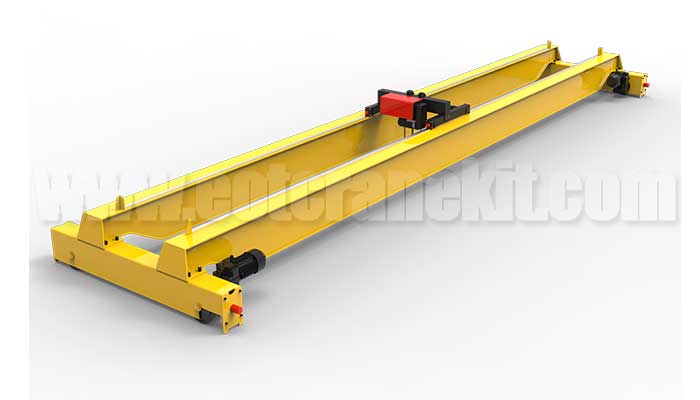
Top Running Double Girder Overhead Cranes with Hoist Trolley
- Description: These cranes feature a hoist trolley that runs on top of the double girders.
- Structure: The hoist trolley moves along the length of the girders, providing a stable and precise method for lifting and positioning heavy loads.
- Uses: Ideal for applications requiring high lifting capacities and precise load control, such as in manufacturing, steel mills, and heavy industrial environments.
- Advantages: Offers robust construction, high load-bearing capacity, and the ability to span large distances without additional support columns.
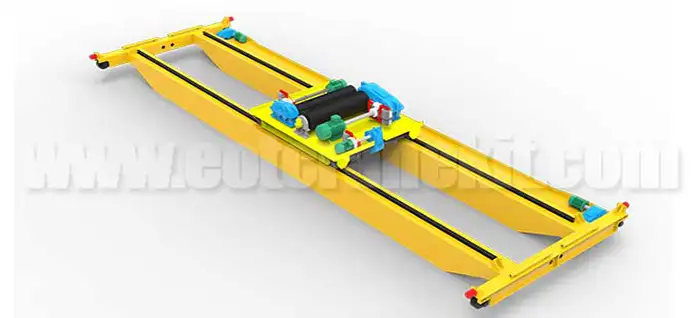
Double Girder Overhead Open Winch Cranes
- Description: These cranes utilize an open winch design where the hoisting mechanism is mounted separately from the girders.
- Structure: The open winch configuration allows for flexibility in load handling and maintenance access.
- Uses: Suitable for heavy-duty lifting tasks in industries like construction, shipbuilding, and logistics where frequent maintenance and easy access to components are essential.
- Advantages: Provides versatility in load handling, ease of maintenance, and the ability to accommodate different types of lifting attachments and configurations.
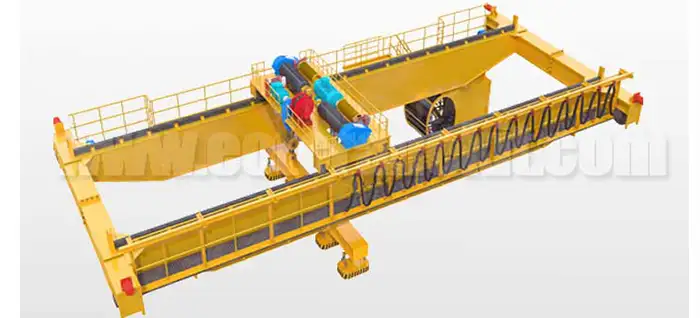
Built-Up Hoist Double Girder Overhead Cranes
- Description: These cranes incorporate a built-up hoist system directly mounted onto the girders.
- Structure: The hoist unit is integrated into the crane structure, offering compactness and efficient load handling capabilities.
- Uses: Commonly used in workshops, warehouses, and assembly lines where space efficiency and high operational speeds are required.
- Advantages: Compact design, reduced maintenance requirements, and high-speed operations make them suitable for rapid material handling and production environments.
Each type of double girder overhead crane offers distinct advantages depending on the specific operational requirements, load capacities, and environmental conditions of the application. Choosing the right type involves considering factors such as lifting capacity, span length, operational speed, maintenance requirements, and the need for customization to optimize efficiency and safety in material handling operations.
Custom Double Girder Overhead Cranes
When Customization is Necessary
Customization of double girder overhead cranes becomes essential when standard models cannot fully meet the specific requirements of a particular application. Situations where customization is necessary include:
- Unique Load Characteristics: When handling unusually shaped, oversized, or extremely heavy loads that require specialized lifting solutions.
- Specific Operational Environments: In environments with extreme temperatures, high humidity, corrosive atmospheres, or hazardous conditions where standard cranes may not perform optimally.
- Space Constraints: When the operational area has unique spatial restrictions that require tailored crane dimensions and configurations.
- Special Functional Requirements: When additional features or advanced control systems are needed to meet specific operational needs, such as precise positioning, automated workflows, or integration with existing systems.
- Regulatory Compliance: When adhering to industry-specific regulations and safety standards that demand unique design features and capabilities.
Options for Custom Designs and Features
Custom double girder overhead cranes can be designed and equipped with a variety of specialized features to meet the exact needs of an operation. Some common customization options include:
- Custom Girder Lengths and Spans: Tailored to fit the specific dimensions of the facility, ensuring optimal coverage and functionality.
- Increased Load Capacity: Enhanced structural design and hoisting mechanisms to accommodate heavier loads than standard models.
- Advanced Hoisting Systems: Including dual hoists for tandem lifting, synchronized hoisting for precise load handling, and variable speed controls for improved operation.
- Specialized Lifting Attachments: Custom hooks, magnets, grabs, and other lifting accessories designed for specific materials and load types.
- Environmental Protection: Features such as corrosion-resistant coatings, weatherproofing, and explosion-proof components to ensure reliable operation in harsh environments.
- Enhanced Control Systems: Integration of advanced control technologies such as remote operation, automated positioning, load monitoring, and safety interlocks.
- Ergonomic and Safety Enhancements: Custom operator cabins, improved visibility, noise reduction features, and comprehensive safety systems to enhance operator comfort and safety.
- Integration with Facility Systems: Compatibility with existing infrastructure, including seamless integration with warehouse management systems, production lines, and maintenance workflows.
In summary, custom double girder overhead cranes provide tailored solutions for unique operational challenges, ensuring that the crane system aligns perfectly with the specific needs and requirements of the application. By offering a wide range of customization options, these cranes enhance productivity, safety, and efficiency in specialized industrial settings.
Types of Processed Double Girder Overhead Cranes for Industrial Sectors
Double girder overhead cranes are adapted and processed to meet specific requirements across various industrial sectors. Here are common types based on their specialized processing and applications:
Explosion-Proof Double Girder Overhead Cranes
- Description: Designed to operate safely in hazardous environments where explosive gases, vapors, or dust may be present.
- Features: Enclosed components, spark-resistant materials, and specialized electrical systems to prevent ignition sources.
- Uses: Found in industries such as oil and gas, chemical processing, and pharmaceuticals where safety regulations require equipment to mitigate explosion risks.
- Advantages: Ensures safety in potentially volatile environments while maintaining efficient material handling capabilities.
Clean Room Double Girder Overhead Cranes
- Description: Engineered to operate in clean room environments such as semiconductor manufacturing, pharmaceutical production, and food processing facilities.
- Features: Stainless steel construction, sealed components, and minimized particle generation to maintain strict cleanliness standards.
- Uses: Handling sensitive materials and components without contamination, ensuring hygiene and product integrity.
- Advantages: Prevents particulate contamination, meets stringent cleanliness requirements, and supports controlled manufacturing processes.
Magnetic Double Girder Overhead Cranes
- Description: Equipped with electromagnetic lifting devices or magnets for handling ferrous materials.
- Features: Integrated magnets or electromagnetic systems capable of lifting and moving metal objects with varying shapes and sizes.
- Uses: Scrap yards, metal recycling plants, and steel mills where efficient handling of metal materials is essential.
- Advantages: Facilitates rapid material pickup and release, improves operational efficiency in metal processing industries.
High-Temperature Double Girder Overhead Cranes
- Description: Engineered to withstand high-temperature environments such as foundries, steel mills, and glass manufacturing facilities.
- Features: Heat-resistant materials, cooling mechanisms for motors and electronics, and specialized coatings to protect against thermal stress.
- Uses: Handling molten metal, glass sheets, and other materials at elevated temperatures without compromising crane performance.
- Advantages: Ensures safe and reliable operation in extreme heat conditions, prolongs crane lifespan, and minimizes downtime.
Cold Storage Double Girder Overhead Cranes
- Description: Designed for use in cold storage facilities and refrigerated warehouses where low temperatures are maintained.
- Features: Insulated components, corrosion-resistant materials, and special lubricants that perform well in sub-zero conditions.
- Uses: Handling goods and materials in food processing, pharmaceutical storage, and frozen food distribution.
- Advantages: Maintains crane functionality in cold environments, prevents frost buildup, and ensures reliable performance without compromising safety.
Foundry and Foundry Duty Double Girder Overhead Cranes
- Description: Designed for heavy-duty operations in foundries and metal casting facilities.
- Features: Heat-resistant components, protective coatings against molten metal splashes, and robust structures for continuous operation in harsh environments.
- Uses: Handling ladles, molds, and heavy castings in foundry operations.
- Advantages: Withstands high temperatures and harsh conditions typical in foundries, ensuring reliable performance and safety.
Railway Double Girder Overhead Cranes
- Description: Specifically designed for railway maintenance and construction applications.
- Features: Specialized attachments for lifting railway components such as tracks, sleepers, and railcars.
- Uses: Railway depots, maintenance facilities, and construction sites for efficient handling of railway infrastructure.
- Advantages: Enhances productivity in railway maintenance operations, supports safe and precise handling of heavy railway components.
Container Handling Double Girder Overhead Cranes
- Description: Customized for loading and unloading containers from trucks, ships, and railcars in ports and container terminals.
- Features: Spreader bars, twist locks, and telescopic spreader beams for secure and efficient container handling.
- Uses: Container terminals, logistics hubs, and ports for rapid container handling operations.
- Advantages: Maximizes throughput and operational efficiency in container handling facilities, supports seamless integration with terminal automation systems.
Paper Mill Double Girder Overhead Cranes
- Description: Designed for paper manufacturing and processing facilities.
- Features: Anti-corrosion coatings, special hooks and attachments for paper rolls, and precise control systems for gentle handling.
- Uses: Paper mills and converting plants for lifting and transporting paper rolls, pulp bales, and related materials.
- Advantages: Prevents damage to sensitive paper products, improves production efficiency, and ensures safe handling in paper manufacturing operations.
Aerospace Industry Double Girder Overhead Cranes
- Description: Tailored for aerospace manufacturing and maintenance facilities.
- Features: Clean room-compatible designs, precision lifting tools for aircraft components, and compliance with aerospace industry standards.
- Uses: Aerospace manufacturing plants, maintenance hangars, and aerospace component production facilities.
- Advantages: Ensures precise handling of delicate and expensive aerospace components, supports stringent safety and quality requirements in aerospace operations.
Each type of processed double girder overhead crane is engineered with specific features and capabilities to optimize performance, safety, and efficiency in its respective industrial sector. By selecting the appropriate crane type based on operational requirements, environmental conditions, and industry standards, organizations can enhance productivity, minimize downtime, and ensure safe material handling operations across diverse industrial applications.
Environmental and Operational Conditions
Indoor vs. Outdoor Cranes: Design and Material Considerations
When selecting a double girder overhead crane for either indoor or outdoor use, it is crucial to understand the distinct design and material requirements for each environment:
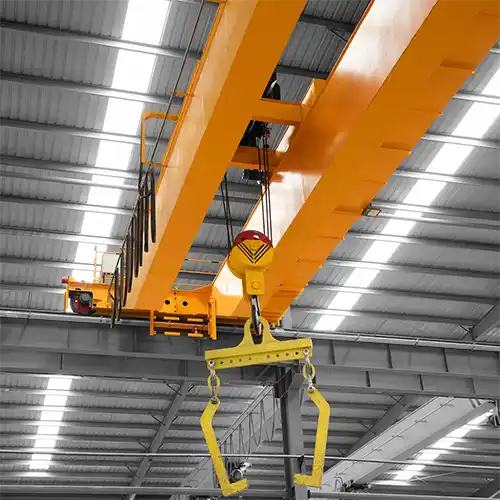
Construction and Materials:
- Typically utilize standard materials suitable for controlled environments, focusing on structural integrity and operational efficiency.
- Common materials include structural steel for girders, mild steel for structural components, and standard protective coatings for corrosion resistance.
Design Features:
- Designed to optimize space utilization within the facility, often featuring compact designs and minimal structural footprints.
- Emphasizes noise reduction mechanisms to minimize operational disturbance and precision control systems for smooth and quiet operation.
Applications:
- Found in manufacturing plants, warehouses, and assembly lines where environmental conditions are controlled and predictable.
- Ideal for handling materials and components with precision and efficiency in indoor settings.
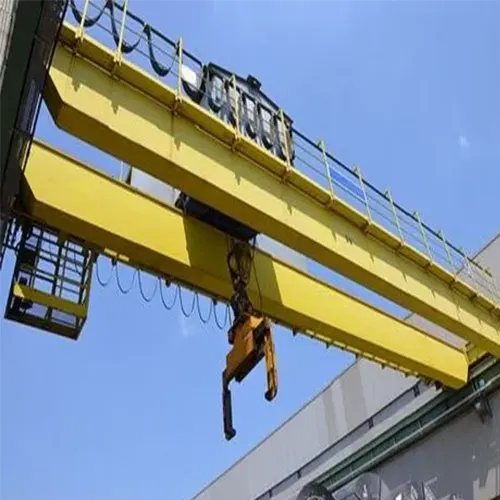
Construction and Materials:
- Constructed with weather-resistant materials capable of withstanding harsh environmental elements such as rain, snow, wind, and fluctuating temperatures.
- Features robust structural components made from corrosion-resistant alloys, galvanized steel, or specialized paints for extended durability.
Design Features:
- Designed to ensure stability and reliability in open and exposed areas, often incorporating reinforced structures and heavy-duty components.
- Equipped with enhanced protective coatings, such as galvanization, epoxy coatings, or specialized paints, to prevent corrosion and rust.
Applications:
- Deployed in outdoor environments such as construction sites, ports, shipyards, and mining operations where exposure to weather elements is unavoidable.
- Designed to handle heavy loads and withstand environmental challenges while maintaining operational efficiency and safety.
Choosing between indoor and outdoor double girder overhead cranes involves evaluating the specific environmental conditions, operational requirements, and material handling challenges unique to each setting. By understanding the differences in design, materials, and features tailored for indoor and outdoor environments, organizations can select the appropriate crane that optimizes productivity, ensures safety, and extends equipment lifespan in their operational contexts.
Protective Measures for Outdoor Cranes
Outdoor cranes are subjected to harsh environmental conditions that can affect their performance and lifespan. Implementing effective protective measures is crucial to ensure reliable operation and durability:
Weatherproof Enclosures:
- Purpose: Protect critical components such as the hoist, motor, and electrical systems from moisture, dust, and debris.
- Implementation: Install weatherproof enclosures or housings around sensitive components to shield them from environmental elements.
- Benefits: Prevents water ingress, corrosion, and electrical malfunctions, ensuring consistent crane performance in all weather conditions.
Wind Resistance Features:
- Purpose: Reinforce crane structures to withstand strong winds and prevent damage or tipping.
- Implementation: Design cranes with robust structural reinforcements and wind-resistant features.
- Benefits: Enhances stability and safety during windy conditions, reducing the risk of crane sway or structural failure.
Temperature Control Systems:
- Purpose: Maintain optimal operating temperatures to ensure crane components function efficiently.
- Implementation: Install temperature control systems such as heaters for cold climates and ventilation for hot environments.
- Benefits: Extends equipment lifespan by preventing thermal stress, condensation buildup, and mechanical failures due to extreme temperatures.
UV Protection:
- Purpose: Protect crane surfaces and structural materials from UV radiation, which can cause fading, degradation, and premature aging.
- Implementation: Apply UV-resistant coatings to crane surfaces and use materials that are inherently resistant to UV damage.
- Benefits: Preserves aesthetics, prevents material degradation, and prolongs the lifespan of outdoor cranes exposed to direct sunlight.
Conclusion: By implementing comprehensive protective measures tailored for outdoor cranes, organizations can mitigate environmental risks, ensure operational reliability, and maximize the longevity of their crane investments. These measures not only safeguard critical components but also enhance safety, efficiency, and overall performance in demanding outdoor environments.
Hazardous Environment Cranes: Explosion-Proof and Other Safety Features
In environments prone to explosions, fires, or exposure to hazardous materials, specialized cranes with robust safety features are crucial to ensure safe operations:
Explosion-Proof Components:
- Purpose: Prevent ignition of flammable gases or dust that could lead to explosions.
- Features: Utilizes explosion-proof motors, electrical systems, and control panels designed to contain and suppress sparks or heat sources.
- Benefits: Minimizes the risk of fire or explosion in volatile environments such as chemical processing plants, refineries, and oil and gas facilities.
Non-Sparking Materials:
- Purpose: Reduces the risk of generating sparks during crane operation, which could ignite flammable atmospheres.
- Components: Incorporates non-sparking materials for critical components like hooks, chains, and trolley wheels.
- Benefits: Enhances safety by mitigating potential ignition sources in areas with combustible gases, vapors, or dusts.
Safety Interlocks:
- Purpose: Ensures safe crane operation under hazardous conditions by preventing unsafe actions or overloads.
- Mechanisms: Includes load limit switches, emergency stop functions, and fail-safe brakes that automatically engage in unsafe situations.
- Benefits: Enhances operational safety and protects personnel and equipment from accidents or equipment failures in high-risk environments.
Fire-Resistant Design:
- Purpose: Provides resistance to high temperatures and prevents the spread of fire in case of an incident.
- Design Features: Uses fire-resistant materials and coatings on crane components to withstand exposure to heat.
- Benefits: Reduces fire hazards and potential damage, ensuring continued operation and minimizing downtime in critical industrial processes.
Hazardous environment cranes with explosion-proof and enhanced safety features are essential for industries where the presence of flammable materials poses significant risks. By integrating these specialized safety measures, organizations can ensure compliance with stringent safety regulations, protect personnel and assets, and maintain reliable operations in hazardous industrial settings.
Compliance with Industry Safety Standards
Ensuring compliance with industry safety standards is paramount when selecting and operating double girder overhead cranes in hazardous environments. Here's how to ensure operational safety and regulatory adherence:
Industry-Specific Regulations:
- Purpose: Adhere to standards tailored for hazardous locations to mitigate risks associated with explosive atmospheres.
- Examples: Compliance with ATEX directives in Europe, NEC regulations in the United States, and other relevant international standards.
- Implementation: Ensure cranes are designed, installed, and operated according to specified safety requirements to prevent ignition of flammable gases, vapors, or dust.
Regular Inspections and Certifications:
- Purpose: Verify ongoing compliance and operational safety through periodic inspections and certifications.
- Process: Conduct routine inspections by authorized personnel or third-party inspectors to assess crane condition, safety features, and adherence to regulatory standards.
- Benefits: Identifies potential hazards, ensures equipment reliability, and maintains legal compliance with safety regulations.
Operator Training:
- Purpose: Equip operators and maintenance personnel with the knowledge and skills to operate cranes safely in hazardous environments.
- Training Programs: Provide comprehensive training on safety protocols, emergency procedures, and hazard awareness specific to the crane's operational environment.
- Importance: Enhances operator competency, reduces the likelihood of accidents, and promotes a safety-focused work culture.
Summary: Selecting the appropriate double girder overhead crane for specific environmental and operational conditions involves meticulous consideration of safety standards and features, especially in hazardous environments. By ensuring compliance with industry-specific regulations, conducting regular inspections, certifications, and providing thorough operator training, organizations can safeguard personnel, protect assets, and maintain operational efficiency while adhering to stringent safety protocols. These measures collectively contribute to safe crane operations and regulatory compliance across various industrial sectors.
Design Features and Specifications
Structural Components
Girder Design and Material Quality
The girders in double girder overhead cranes are the primary load-bearing elements and play a crucial role in the crane's overall performance and durability:
- Design: Double girders are designed to distribute the load evenly across both beams, enhancing stability and load capacity. Common designs include box girders and rolled steel profiles, each offering different advantages in terms of strength and fabrication efficiency.
- Material Quality: High-quality steel is typically used for girders to ensure strength and longevity. The material should be resistant to wear, fatigue, and corrosion, especially in harsh environments. Advanced manufacturing processes such as welding and precision machining are employed to maintain structural integrity and alignment.
End Trucks and Rail Compatibility
End trucks are essential for the movement of the crane along the runway beams:
- Design: End trucks house the wheels and drive mechanisms that allow the crane to travel. They must be robustly constructed to handle the weight of the crane and the load.
- Rail Compatibility: The end trucks must be compatible with the runway rails to ensure smooth and efficient travel. This involves matching the wheel profiles to the rail design and ensuring proper alignment. Regular maintenance and alignment checks are necessary to prevent wear and ensure safe operation.
Hoisting Mechanism
Types of Hoists and Their Specifications
The hoisting mechanism is a critical component that determines the crane's lifting capabilities:
- Wire Rope Hoists: Known for their strength and durability, wire rope hoists are ideal for heavy-duty applications. They offer high lifting capacities and precise load control.
- Chain Hoists: Suitable for lighter loads, chain hoists are more compact and easier to maintain. They are typically used in smaller facilities or for less demanding applications.
- Specifications: Key specifications include lifting capacity, lifting speed, and the length of the lifting medium (wire rope or chain). It is important to select a hoist that matches the operational needs and load requirements of the application.
Factors Affecting Hoist Selection
Selecting the appropriate hoist involves considering several factors:
- Load Capacity: Ensuring the hoist can handle the maximum weight of the loads to be lifted.
- Lifting Speed: Matching the lifting speed to the operational requirements for efficiency and safety.
- Duty Cycle: The frequency and duration of use, which affects the selection of hoist components and their durability.
- Environmental Conditions: Considering factors such as temperature, humidity, and exposure to corrosive substances, which may require specialized hoists.
Control Systems
Manual vs. Automated Controls
Control systems determine how the crane is operated and can significantly impact efficiency and safety:
- Manual Controls: Typically involve a pendant or joystick controller that allows the operator to manually control the crane's movements. They are simple, cost-effective, and suitable for straightforward applications.
- Automated Controls: Advanced systems that enable automated or semi-automated operation. These may include programmable logic controllers (PLCs), remote control units, and integration with facility management systems. Automated controls enhance precision, efficiency, and safety, especially in complex or repetitive tasks.
Safety and Precision Features
Ensuring the safe and precise operation of double girder overhead cranes involves incorporating various features:
Safety Features:
- Overload Protection: Systems that prevent the crane from lifting loads beyond its rated capacity.
- Emergency Stop: Immediate cessation of crane operation in case of an emergency.
- Anti-Collision Systems: Sensors and controls to prevent collisions with obstacles or other equipment.
Precision Features:
- Variable Speed Control: Allows for smooth acceleration and deceleration, reducing the risk of load swinging and ensuring precise positioning.
- Positioning Systems: Technologies such as laser or GPS-based systems that provide accurate load positioning and tracking.
In summary, understanding the design features and specifications of double girder overhead cranes, including structural components, hoisting mechanisms, and control systems, is essential for selecting the right crane for your specific needs. These considerations ensure optimal performance, safety, and efficiency in industrial operations.
Customization and Special Features
Tailoring Cranes to Specific Applications

Custom Girder Lengths and Hook Paths
Customizing the girder lengths and hook paths of double girder overhead cranes allows for optimal fit and functionality in specific applications:
- Custom Girder Lengths: Tailoring the length of the girders ensures that the crane fits perfectly within the operational space, maximizing coverage and efficiency. This customization is crucial for facilities with unique dimensions or spatial constraints.
- Hook Paths: Customizing the hook path involves designing the crane to achieve specific lifting and lowering trajectories. This ensures that the crane can handle unique load requirements and navigate around obstacles, providing precise and efficient material handling.
Special Load Handling Attachments
Special load handling attachments enhance the versatility and capability of double girder overhead cranes:
- Custom Hooks: Designed to handle specific types of loads, such as coils, bars, or irregularly shaped items.
- Magnets and Grabs: Useful for handling ferrous materials or bulk items, these attachments can be customized to suit specific material handling needs.
- Spreader Beams: Allow for lifting long or wide loads by distributing the load evenly across multiple lifting points.
- Lifting Clamps: Ideal for securely handling plates, sheets, and other flat materials.
Advanced Technology Integration
Smart Crane Systems and IoT
Integrating advanced technology into double girder overhead cranes enhances their functionality and efficiency:
- Smart Crane Systems: Utilize sensors, data analytics, and automation to optimize crane operations. Features include automated load positioning, real-time performance monitoring, and predictive maintenance alerts.
- Internet of Things (IoT): Connecting cranes to IoT platforms enables seamless data exchange between the crane and other systems. This integration supports advanced analytics, remote diagnostics, and efficient management of crane operations.
Remote Monitoring and Control Capabilities
Remote monitoring and control capabilities provide significant advantages in terms of efficiency, safety, and maintenance:
- Remote Monitoring: Allows operators and maintenance personnel to track the crane's performance and status in real-time from any location. This includes monitoring load weights, operational cycles, and potential faults.
- Remote Control: Enables operators to control the crane from a safe distance, reducing the need for on-site presence and enhancing safety in hazardous environments. Advanced remote control systems can include features such as video feeds, touchscreens, and ergonomic controls.
In summary, customizing double girder overhead cranes to specific applications and integrating advanced technology can significantly enhance their performance, versatility, and safety. These customizations and special features ensure that the crane meets the unique needs of the operation, providing efficient and reliable material handling solutions.
Cost Considerations
Initial Investment vs. Long-term Value
Cost Breakdown of Standard vs. Custom Cranes
When evaluating the cost of double girder overhead cranes, it's essential to consider both the initial investment and the long-term value they provide:
Standard Cranes: Typically have lower initial costs due to standardized designs and components. The cost breakdown includes:
- Equipment Cost: Base cost of the crane, including structural components, hoisting mechanisms, and control systems.
- Installation: Expenses related to crane installation, such as assembly, commissioning, and integration into existing infrastructure.
- Training: Costs associated with operator training and familiarization with the crane's operation.
- Additional Features: Optional extras, such as safety upgrades or ergonomic enhancements.
Custom Cranes: Involve higher initial investment due to tailored designs and specialized features. The cost breakdown includes:
- Engineering and Design: Costs associated with custom engineering, including feasibility studies, design modifications, and customization of structural components.
- Materials: Expenses related to specialized materials, coatings, and components required for customization.
- Installation and Integration: Similar to standard cranes but may include additional costs for custom features or unique installation requirements.
- Training and Support: Comprehensive training for operators and maintenance staff on handling specialized equipment.
Evaluating ROI and Operational Efficiency
Assessing the return on investment (ROI) and operational efficiency involves comparing the upfront costs with the long-term benefits:
- ROI Calculation: Consider factors such as increased productivity, reduced downtime, and improved safety resulting from the crane's performance.
- Operational Efficiency: Custom cranes may offer higher efficiency due to optimized design and specialized features that align with specific operational requirements.
- Total Cost of Ownership (TCO): Includes not only the initial purchase price but also ongoing maintenance, repairs, and operational costs over the crane's lifespan.
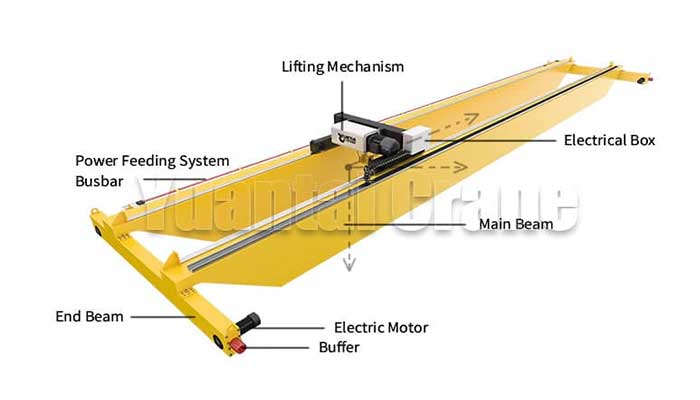
Double Girder Overhead Crane For Sale
The double girder crane can lift loads from 5 to 63 ton, which is widely used in machinery fabrication, metallurgical plant auxiliary workshop, storage, stock ground, and power station, textile industry and food industry.
Custom 10 Ton Overhead Crane with Double Girder Design Price Range
- Span: 7.5~31.5 meters
- Lifting Height: 6~30 meters
- Power Supply: 220-480V/3-phase/50Hz
- Price: $6,500 - $79,000
The price range is for reference, which will be changed with time and other factors. Contct us to get the latest price.
Maintenance and Operational Costs
Regular Maintenance Requirements
Maintaining double girder overhead cranes is essential for ensuring safety, reliability, and longevity:
- Routine Inspections: Regular checks of structural components, electrical systems, hoisting mechanisms, and safety features.
- Lubrication: Scheduled lubrication of moving parts to prevent wear and ensure smooth operation.
- Adjustments and Alignments: Periodic adjustments to maintain proper alignment of rails, end trucks, and hoisting mechanisms.
- Component Replacement: Replacement of worn-out or damaged components, such as wire ropes, bearings, and electrical contacts.
Predictive Maintenance and Cost-saving Strategies
Implementing predictive maintenance strategies can reduce downtime and maintenance costs:
- Condition Monitoring: Using sensors and data analytics to monitor crane performance and detect early signs of equipment wear or failure.
- Predictive Analytics: Analyzing data to predict maintenance needs and schedule repairs proactively, minimizing unplanned downtime.
- Scheduled Maintenance Plans: Developing comprehensive maintenance schedules based on equipment usage, environmental factors, and manufacturer recommendations.
- Training Programs: Investing in training for maintenance personnel to enhance their skills in troubleshooting, diagnostics, and preventive maintenance practices.
In conclusion, while initial costs vary between standard and custom double girder overhead cranes, assessing long-term value, ROI, and operational efficiency is crucial. Implementing effective maintenance strategies further enhances cost-effectiveness and ensures optimal crane performance throughout its service life.
Collaboration with Manufacturers and Suppliers
Selecting a Reliable Manufacturer
Criteria for Choosing a Crane Manufacturer
Choosing the right manufacturer for double girder overhead cranes involves evaluating several critical criteria:
- Experience and Expertise: Look for manufacturers with extensive experience in designing, manufacturing, and installing overhead cranes, particularly double girder models.
- Reputation and Track Record: Assess customer reviews, testimonials, and case studies to gauge the manufacturer's reputation for quality, reliability, and customer satisfaction.
- Engineering Capabilities: Ensure the manufacturer has a strong engineering team capable of customizing cranes to meet specific requirements and integrating advanced technologies.
- Quality Standards: Verify that the manufacturer adheres to international quality standards and certifications relevant to crane manufacturing (e.g., ISO 9001).
- Flexibility and Customization: Evaluate the manufacturer's ability to offer customized solutions tailored to unique operational needs, including design modifications and specialized features.
- Support Services: Consider the availability of technical support, training programs, and after-sales services to ensure ongoing support throughout the crane's lifecycle.
Importance of After-Sales Support and Service
After-sales support is crucial for maintaining optimal crane performance and minimizing downtime:
- Technical Support: Prompt assistance from knowledgeable service technicians for troubleshooting, repairs, and maintenance.
- Spare Parts Availability: Accessibility to genuine spare parts ensures timely replacements and minimizes disruptions to operations.
- Training Programs: Comprehensive training for operators and maintenance personnel to maximize crane efficiency and safety.
- Service Agreements: Options for service contracts or maintenance agreements to ensure regular inspections and proactive maintenance.
- 24/7 Support: Availability of emergency support and remote diagnostics to address urgent issues promptly.
Partnership for Custom Solutions
Working Closely with Manufacturers for Tailored Solutions
Collaborating closely with crane manufacturers facilitates the development of customized solutions that precisely meet operational requirements:
- Needs Assessment: Conducting thorough assessments to identify specific operational challenges, load requirements, and environmental factors.
- Engineering Consultation: Engaging with the manufacturer's engineering team to explore design options, feasibility studies, and prototype development.
- Prototyping and Testing: Iterative testing and refinement of prototypes to ensure compatibility, functionality, and safety compliance.
- Project Management: Coordinating project timelines, installation schedules, and commissioning activities in collaboration with the manufacturer.
- Documentation and Compliance: Ensuring that customized solutions meet regulatory standards, industry-specific requirements, and safety certifications.
Ensuring Quality and Compliance with Standards
Ensuring that the manufacturer maintains high standards of quality and compliance is essential:
- Quality Assurance: Verification of manufacturing processes, material traceability, and quality control measures throughout production.
- Certifications: Confirming adherence to relevant international standards (e.g., CE marking, ANSI, CSA) for safety, performance, and environmental impact.
- Inspections and Audits: Conducting periodic audits and inspections to validate compliance with contractual agreements and regulatory requirements.
- Continuous Improvement: Engaging in continuous improvement initiatives to enhance product reliability, efficiency, and customer satisfaction.
By selecting a reliable manufacturer and fostering a collaborative partnership, organizations can leverage expertise, innovation, and support services to acquire double girder overhead cranes that meet their specific operational needs while ensuring long-term reliability and compliance with industry standards.
Regulatory and Safety Standards
Industry Regulations and Compliance
Key Regulations Affecting Crane Design and Operation
Understanding and complying with industry regulations are crucial for ensuring the safe design, operation, and maintenance of double girder overhead cranes:
- OSHA (Occupational Safety and Health Administration): Sets regulations in the United States for crane safety, including crane operator certification, inspection requirements, and safety protocols.
- CE Marking: Required in Europe to indicate conformity with health, safety, and environmental protection standards for machinery, including overhead cranes.
- ANSI/ASME Standards: American National Standards Institute and American Society of Mechanical Engineers provide guidelines on crane design, installation, operation, maintenance, and safety.
- Other Local Regulations: Each country or region may have specific regulations governing crane operations, workplace safety, electrical safety, and environmental protection.
Ensuring Compliance with Local and International Standards
Meeting regulatory standards involves:
- Design and Construction: Ensuring that crane designs meet structural integrity requirements, load capacities, safety factors, and environmental conditions specified in relevant standards.
- Installation and Commissioning: Following guidelines for proper installation, alignment, and testing of cranes to ensure safe and reliable operation.
- Operation and Maintenance: Implementing procedures for safe crane operation, regular inspections, preventive maintenance, and record-keeping to comply with regulatory requirements.
- Documentation and Certifications: Obtaining necessary certifications, documentation, and permits demonstrating compliance with applicable standards and regulations.
Safety Features and Protocols
Essential Safety Features for Overhead Cranes
Incorporating essential safety features enhances crane safety and mitigates operational risks:
- Overload Protection: Systems that prevent the crane from lifting loads exceeding its rated capacity, including overload limit switches and load moment indicators.
- Emergency Stop Devices: Immediate cessation of crane movement in emergencies, accessible from multiple points along the crane's path.
- Limit Switches: Controls that prevent the crane from traveling beyond specified limits, ensuring safe operation within designated areas.
- Collision Avoidance Systems: Sensors and alarms that detect obstacles or other cranes to prevent collisions during operation.
- Anti-Sway Control: Systems that minimize load sway and improve load control during lifting and lowering operations.
Training and Operational Safety Measures
Training Programs
Comprehensive training programs are essential for safe crane operation:
- Operator Training: Training courses covering crane controls, load handling techniques, safety procedures, and emergency protocols.
- Maintenance Training: Instruction on routine inspections, preventive maintenance tasks, and troubleshooting procedures for maintenance personnel.
- Safety Awareness: Promoting awareness of potential hazards, safe work practices, and regulatory compliance among all personnel involved in crane operations.
Operational Safety Measures
Implementing operational protocols and safety measures includes:
- Pre-Operational Inspections: Conducting thorough checks of crane components, controls, and safety devices before each use.
- Clear Communication: Establishing clear communication channels between operators, signal persons, and personnel in the vicinity of crane operations.
- Emergency Response Plans: Developing and practicing emergency response plans for crane accidents, including evacuation procedures and first aid protocols.
- Continuous Improvement: Regularly reviewing and updating safety procedures based on incident reports, near misses, and regulatory updates to enhance safety performance.
By adhering to regulatory requirements, integrating essential safety features, and prioritizing comprehensive training and operational safety measures, organizations can ensure the safe and compliant operation of double girder overhead cranes, protecting personnel and assets while maintaining productivity and efficiency.
Case Studies and Examples
Successful Implementations
Examples of 10-ton Double Girder Cranes in Various Industries
Double girder overhead cranes with a 10-ton capacity have been successfully implemented across diverse industries, demonstrating their versatility and effectiveness in material handling:
10 ton double girder bridge crane projects and cases for your reference.
Manufacturing Industry:
- Automotive Assembly Plants: Used for lifting heavy components such as engines, chassis, and vehicle bodies during assembly processes. The cranes are equipped with precise control systems to ensure accurate positioning.
- Steel and Metal Fabrication: Ideal for handling large steel plates, beams, and coils in fabrication shops. Customized features include special lifting attachments for different types of materials.
Construction and Infrastructure:
- Pre-Cast Concrete Plants: Employed for lifting and moving pre-cast concrete elements such as beams, columns, and panels. The cranes feature robust design and high load capacity to handle heavy concrete pieces.
- Bridge Construction: Used for lifting and placing structural components during bridge construction, including steel girders and concrete segments. Advanced control systems ensure precise alignment and placement.
Mining and Heavy Industries:
- Mining Operations: Utilized in mining environments for handling ore, machinery, and equipment. Explosion-proof features and rugged construction are essential to withstand harsh conditions.
- Steel Mills: Deployed for handling molten metal ladles, ingots, and heavy machinery components. Heat-resistant materials and protective coatings are incorporated for durability.
Logistics and Warehousing:
- Container Yards: Used for loading and unloading containers from trucks and ships. The cranes are equipped with spreader bars and container lifting attachments for efficient cargo handling.
- Distribution Centers: Deployed for lifting and stacking pallets, crates, and bulk goods in logistics operations. High-speed hoisting mechanisms and automated controls enhance operational efficiency.
Lessons Learned and Best Practices
- Customization for Specific Needs: Tailoring crane specifications and features to meet unique operational requirements improves efficiency and safety.
- Integration of Advanced Technologies: Implementing smart crane systems, IoT connectivity, and remote monitoring enhances operational visibility and maintenance planning.
- Compliance with Standards: Adhering to regulatory standards ensures safety and legal compliance, preventing accidents and operational disruptions.
- Regular Maintenance and Training: Scheduled maintenance and ongoing training programs for operators and maintenance personnel prolong crane lifespan and optimize performance.
- Collaboration with Experienced Manufacturers: Partnering with reputable crane manufacturers ensures quality, reliability, and effective support throughout the crane's lifecycle.
These case studies illustrate how 10-ton double girder overhead cranes contribute to operational efficiency, safety, and productivity across various industries. By learning from successful implementations and adopting best practices, organizations can effectively leverage these cranes to streamline material handling processes and achieve business objectives.
Conclusion
Summary of Key Points
In summary, choosing a 10-ton double girder overhead crane involves evaluating several critical factors to ensure optimal performance, safety, and efficiency. Key considerations include capacity and load requirements, span and hook height specifications, customization options, environmental conditions, regulatory compliance, safety features, and collaboration with experienced manufacturers.
Recap of Important Considerations and Features
- Capacity and Load Requirements: Assessing maximum load capacities and considerations for dynamic and static loads to determine crane suitability.
- Span and Hook Height: Determining appropriate span lengths and hook heights based on operational needs and spatial constraints.
- Customization Options: Tailoring cranes with custom features such as special attachments, advanced technology integration, and specific design modifications.
- Environmental and Operational Conditions: Addressing factors like indoor vs. outdoor use, hazardous environment requirements, and protective measures.
- Regulatory Compliance and Safety Features: Ensuring adherence to industry regulations, integrating essential safety features, and prioritizing operator training.
- Collaboration with Manufacturers: Selecting reliable manufacturers for tailored solutions, emphasizing after-sales support, and ensuring quality and compliance.
Final Recommendations
When making decisions regarding 10-ton double girder overhead cranes, it's crucial to:
- Evaluate Specific Needs: Conduct thorough assessments of operational requirements, space limitations, and load characteristics to determine the most suitable crane configuration.
- Consult with Experts: Seek guidance from crane manufacturers and industry experts to leverage their knowledge and experience in crane design, installation, and maintenance.
- Prioritize Long-term Value: Consider not only the initial investment but also the long-term benefits, including operational efficiency, reliability, and maintenance costs.
Guidance on Making an Informed Decision
To make an informed decision, prioritize:
- Performance Requirements: Choose a crane that aligns with specific performance needs, such as lifting capacity, speed, and precision.
- Safety and Compliance: Ensure the crane meets or exceeds regulatory requirements and incorporates essential safety features to protect personnel and assets.
- Support and Service: Select a manufacturer that offers comprehensive after-sales support, including maintenance services, spare parts availability, and training programs.
- Customization Flexibility: Opt for a crane manufacturer capable of customizing designs and features to optimize crane functionality for unique operational environments.
Encouragement to Assess Specific Needs and Consult with Experts
Assessing your specific operational needs and consulting with crane manufacturers and industry experts will empower you to choose the right 10-ton double girder overhead crane that enhances productivity, ensures safety, and supports long-term operational success. By leveraging expertise and carefully considering all aspects, you can make a well-informed decision that meets your business objectives effectively.
Frequently Asked Questions (FAQs)
Common Buyer Concerns
What factors should I consider when choosing a 10-ton double girder overhead crane?
When selecting a 10-ton double girder overhead crane, consider:
- Capacity and Load Requirements: Ensure the crane can handle your maximum load capacities, both statically and dynamically.
- Span and Hook Height: Determine the appropriate span length and hook height based on your operational needs and facility layout.
- Customization Options: Evaluate if customization is necessary to meet specific operational challenges or environmental conditions.
- Safety Features: Verify that the crane incorporates essential safety features to comply with industry regulations and enhance workplace safety.
- Manufacturer's Reputation: Choose a reputable manufacturer known for quality, reliability, and excellent after-sales support.
What are the advantages of double girder overhead cranes over single girder cranes?
Double girder overhead cranes offer several advantages:
- Higher Load Capacities: They can lift heavier loads compared to single girder cranes.
- Greater Span Lengths: Double girders provide longer spans, allowing for coverage of larger areas without additional support columns.
- Durability and Longevity: Due to their robust design, double girder cranes are more suitable for intensive and continuous operations.
- Customization Flexibility: They often offer more customization options to meet specific operational requirements and challenges.
- Improved Stability and Precision: Double girder cranes provide enhanced stability and precision in load handling and positioning.
How can I ensure the safety of overhead crane operations?
To ensure the safety of overhead crane operations:
- Regular Inspections: Conduct routine inspections of the crane, including structural components, electrical systems, and safety devices.
- Operator Training: Provide comprehensive training for crane operators on safe operating procedures, load handling techniques, and emergency protocols.
- Safety Features: Ensure the crane is equipped with essential safety features such as overload protection, limit switches, emergency stop devices, and collision avoidance systems.
- Compliance with Regulations: Adhere to local and international safety regulations and standards governing crane operations and workplace safety.
- Maintenance Practices: Implement preventive maintenance schedules and practices to keep the crane in optimal working condition and prevent potential failures.
Addressing these FAQs based on industry expertise ensures that buyers have a comprehensive understanding of the factors influencing their crane purchase decisions. By prioritizing safety, performance, and reliability, organizations can effectively choose and maintain a 10-ton double girder overhead crane that meets their operational needs and enhances productivity while ensuring a safe working environment.
Related Products

Latest project
150 Ton Overhead Crane Installation Feedback – Paraguay Case
QDX 150 ton overhead crane in action in Paraguay. Installation photos, video, and client feedback show performance, safety, and heavy-lifting efficiency.
Free consultation to Confirm Parameters & Specifications and Get
Latest Crane Price & Crane Rate.
- Types of overhead cranes : _______?
- Optional: Overhead travelling crane, goliath gantry crane,Slewing jib crane, Single girder or double girder crane,small portable crane or kbk crane, etc.
- Capacity of overhead crane: _______?
- Optional: 0.25ton, 0.5 ton, 1 ton, 2 ton, 3ton, 5 ton, 10 ton,15ton, 20ton, 25 ton, 30ton,35ton, up to 550ton, etc.
- Crane span & lifting height : _______?
- Crane travelling length : _____?
- Control of overhead crane:_______?
- Optional: pendant/ remote/cabin control
- Voltage supply of overhead crane:_____?
- Eg,: 380V50/60HZ,3Phase or others,etc.
- Application/usage of crane:_______?
- Eg,: Steel mill, ,injection mold, cement,stone, concrete,granite, general manufacturing, etc.
Just leave a message via the contact form and our hoist and crane engineer will contact you with in 24working hours.
Get In Touch

